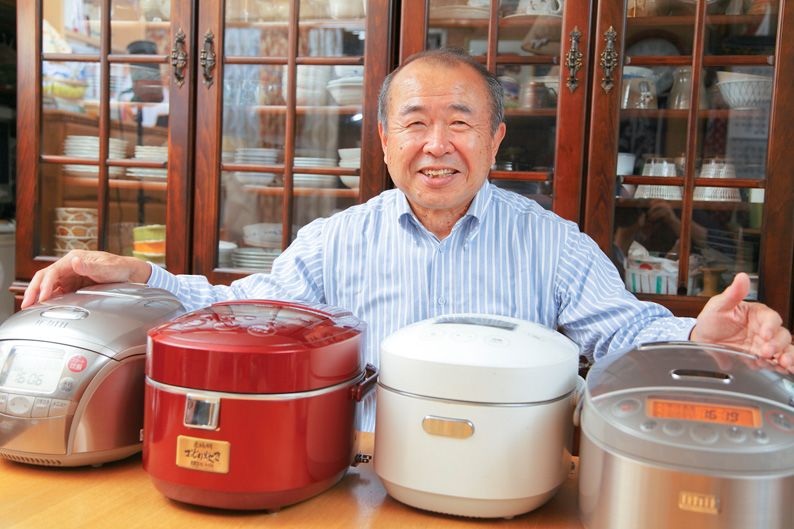
New Appliances for the Old Taste
Society Lifestyle- English
- 日本語
- 简体字
- 繁體字
- Français
- Español
- العربية
- Русский
In 1992 Shimozawa Masayuki, an engineer at Tottori Sanyō Electric Co., Ltd., achieved a breakthrough in the field of high-tech rice cookers with the development of the industry’s first electric cooker employing induction heating. During his career Shimozawa had a hand in the creation of more than 200 rice cooker models. He became known as the “god of rice cookers” because of his vast experience in the development of these kitchen appliances, but his technological expertise extends far beyond that. He also has a wealth of knowledge about rice varieties, methods of refining rice, and ways of eating it. Shimozawa is now retired, but from the perspective of a developer, he is still in pursuit of the ultimate rice.
 Shimozawa, “god of rice cookers,” has four cookers in his home.
Shimozawa, “god of rice cookers,” has four cookers in his home.
From the Age of Convenience to the Age of Taste
We asked Shimozawa about his image of the most delicious rice. He replied, “It’s rice that retains the feel of separate kernels, has a definite sweetness, and is not soggy. And it leaves a refreshing aftertaste in your mouth after each bite. For more than 35 years I’ve been in pursuit of this ideal taste.”
Sanyō put Shimozawa in charge of developing rice cookers back in 1975, after Japan had transitioned from its era of high-speed growth to the next stage of economic development. Once the 1980s rolled in, he recalls, the market for rice cookers underwent a sea change. “In the seventies there was a real emphasis on speed. It was an age when people wanted things that operated more rapidly and conveniently. As long as rice wasn’t undercooked and crunchy, they were satisfied. But with the rollout of cookers equipped with microprocessors in 1982, momentum began to build toward a desire for good-tasting rice.”
Shimozawa’s Revolutionary Odoridaki Model
Initially the government bought rice from farmers and sold it to consumers, but it gradually moved in the direction of liberalization, giving farmers more freedom to market their crops independently. In 1987 independently marketed rice moved out in front of government-purchased rice. Around 1992 several new varieties went into distribution under such brand names as Koshihikari, Hitomebore, and Hinohikari, and their growing popularity added fuel to the growing demand for tasty rice.
“Until then,” Shimozawa recalls, “people had been eating rice without much thought, but I sensed they were developing an interest in tastier rice. With consumer preferences shifting, we adjusted our development goals accordingly. What the Japanese perceive as the ideal is, in a word, rice cooked on a kamado [a traditional wood-fired stove for cooking rice]. They were hoping for cookers capable of reproducing that taste.”
Development and testing continued as the years rolled on, culminating in the Odoridaki model, which went on sale in 2002. With a built-in mechanism for altering the pressure in the pot, this model in effect stirs the rice as it boils, making the grains seem to dance as they cook. Odoridaki is the buzzword created to describe this, coined from odoru (to dance) and taku (to cook). The result is rice just like that cooked on a kamado, with soft, full, and glossy grains. Although this was an expensive rice cooker, costing around ¥100,000, it was a big hit, becoming a showcase item among twenty-first-century appliances.
Aiming to Deliver Pleasure, Not to Make Things
 “As Japan entered the age of affluence and people became able to eat whatever they wanted to,” Shimozawa says, “more and more of them paused to give thought to the essence of foods. True luxury, they concluded, comes from eating delicious rice with their everyday meals. As a developer, I was strongly inclined to deliver pleasure through products, not just to make things. When the Japanese are able to enjoy tasty rice, they become happy. I saw the rice cooker as a way to deliver of this perhaps trifling, but vital, sense of happiness in everyday life.”
“As Japan entered the age of affluence and people became able to eat whatever they wanted to,” Shimozawa says, “more and more of them paused to give thought to the essence of foods. True luxury, they concluded, comes from eating delicious rice with their everyday meals. As a developer, I was strongly inclined to deliver pleasure through products, not just to make things. When the Japanese are able to enjoy tasty rice, they become happy. I saw the rice cooker as a way to deliver of this perhaps trifling, but vital, sense of happiness in everyday life.”
Currently Shimozawa devotes his time to fostering successors in the field of rice cooker development. He is also engaged in lecture activities involving demonstrations of how rice is best prepared and eaten. “These days,” he reflects, “the Japanese only eat half as much rice as they used to fifty years ago. If they became acquainted with truly delicious rice, though, surely they’d want to eat more of it. That’s why I’m trying to pass on a total package of information starting from methods of cooking rice. I’d like to be able to help change attitudes toward this staple.”
Related Tags
Electric rice cooker Tottori Sanyō Electric Toshiba Home Appliances Induction heating Odoridaki Kamado Kamadodaki Microprocessors High-tech Shimozawa Masayuki Morimichi Nobuaki


